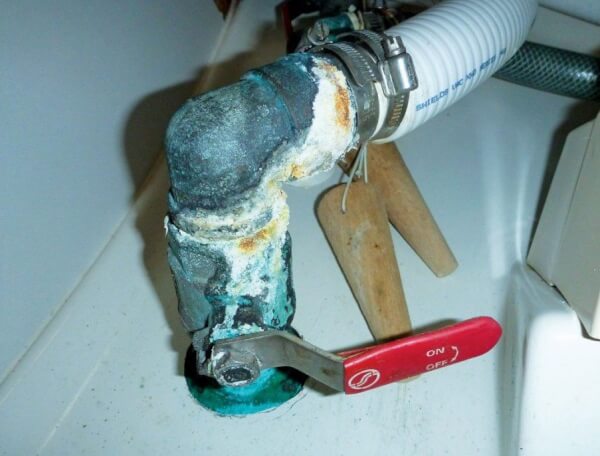According to BoatUS, 50% of all boats that sink do so as the result of failed underwater fittings. Given this fact it is surprising how little care most boat owners give to this important hardware. As a surveyor, it is part of my job to inspect a vessel’s thru-hulls, seacock and associated hoses during my surveys. I am often surprised at just what I find. Old, dry rotted hoses on corroded fittings attached to a frozen seacock are more common than those in good condition. More than once while checking the operation of a seacock I have had a handle come off in my hand with little effort on my part.
Although nobody likes crawling around in bilges, putting off this one chore could literally get you in deep water. Equally as important is to make sure all your underwater gear is in good condition. I suggest at least twice a year all underwater fittings and hoses be inspected and tested for proper operation. This will also help the owner become familiar with the location of all these critical fittings. If any fittings are hard or impossible to reach, it may be time to think about relocating them to more accessible locations.

When checking your underwater pumping, start by making sure the sea valves work easily by hand. For larger valves, an extension for additional leverage may help. Make sure all valves are fitted with handles and there is nothing obstructing the full swing of the handle. If your vessel is electrically bonded, check that bonding wires are intact and the connection is not corroded. Any backing block should be checked for general condition as well. Wood blocks tend to get soft with age in wet areas.
Next, check all the fittings for corrosion. I have found more often than not, when a failure occurs it happens at the fittings attached to the valves. Very often a pipe to hose barb is fitted. It is in the threads of these fittings that the most corrosion occurs. The hose can also trap moisture on or near these threads adding to the problem. Pay close attention to plastic fittings as well, as these can crack from age or excessive side pressure from the hose.
Check the hoses for signs of cracking and dry rot. Surprisingly, I am seeing more and more hoses just a few years old cracking, and in some cases, leaking. Follow the hose to its ends and inspect any fittings and connections at both ends. Make sure all the hose clamps are tight and rust free. Hose clamps can and do loosen with age and vibration.
If your vessel has air conditioning pay special attention to all these fittings and hoses. A simple drip while the vessel is sitting can accelerate while it is in operation. The fittings on most air conditioner pumps tend to be problematic and care should be taken that all hoses connected to the pump are well supported with no side loads.

All fittings on the engines should be inspected carefully as well, to include exhaust hoses and fittings that are at or below the waterline. The greatest percentage of boats that sink while underway do so because of failed engine fittings or hoses. Engines pumping water through a leaking hose can quickly fill a bilge without the operator ever noticing it. Stuffing boxes and shaft glands should also be checked both in the slip and underway. Today’s dripless seals can be great for keeping the bilges dry, but can let a large amount of water in, should they fail. Be sure to check the hose clamps here as well.
High water alarms are great for knowing about leaks early and I strongly recommend all boats be fitted with these simple devices. The alarms are basically a high water switch mounted a few inches above the normal bilge level with a buzzer or siren mounted at or near the helm. When a boat is in operation, the sound will let the operator know quickly when there is a problem, and while at the slip, will alert the dock master of a problem.
As we gear up for the new boating season, now is a good time to check all your under water fittings. This is particularly true of any boats that might have spent the winter in colder climates where freezing can break or weaken fittings. An hour or so of time could save you thousands in repair costs and possibly save your life.






Thanks for the info. Are there any sort of safety precautions I should have in place when checking seacocks? (Such as plugs on hand or a bilge pump on standby or something if things start leaking) Sorry if this is a total noob question, I don’t know the first thing about inspecting them. (other than what I just read)
You should always have an assortment of soft wooden plugs on hand… and your bilge pump should be on a float switch, but a bilge pump is of little use if a seacock breaks off, it will sink your boat in 15 minutes, so know exactly where your wood plugs are, always.